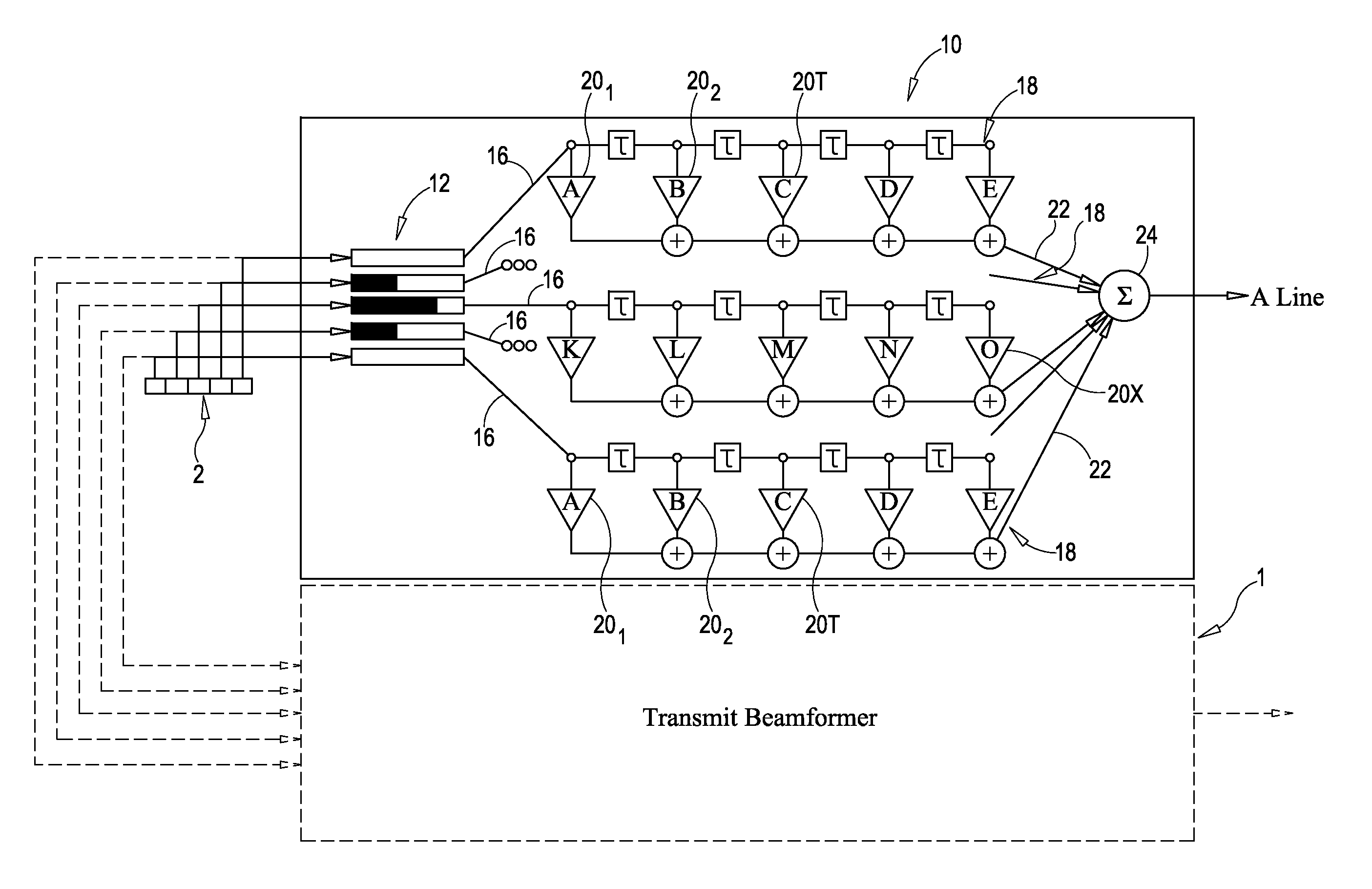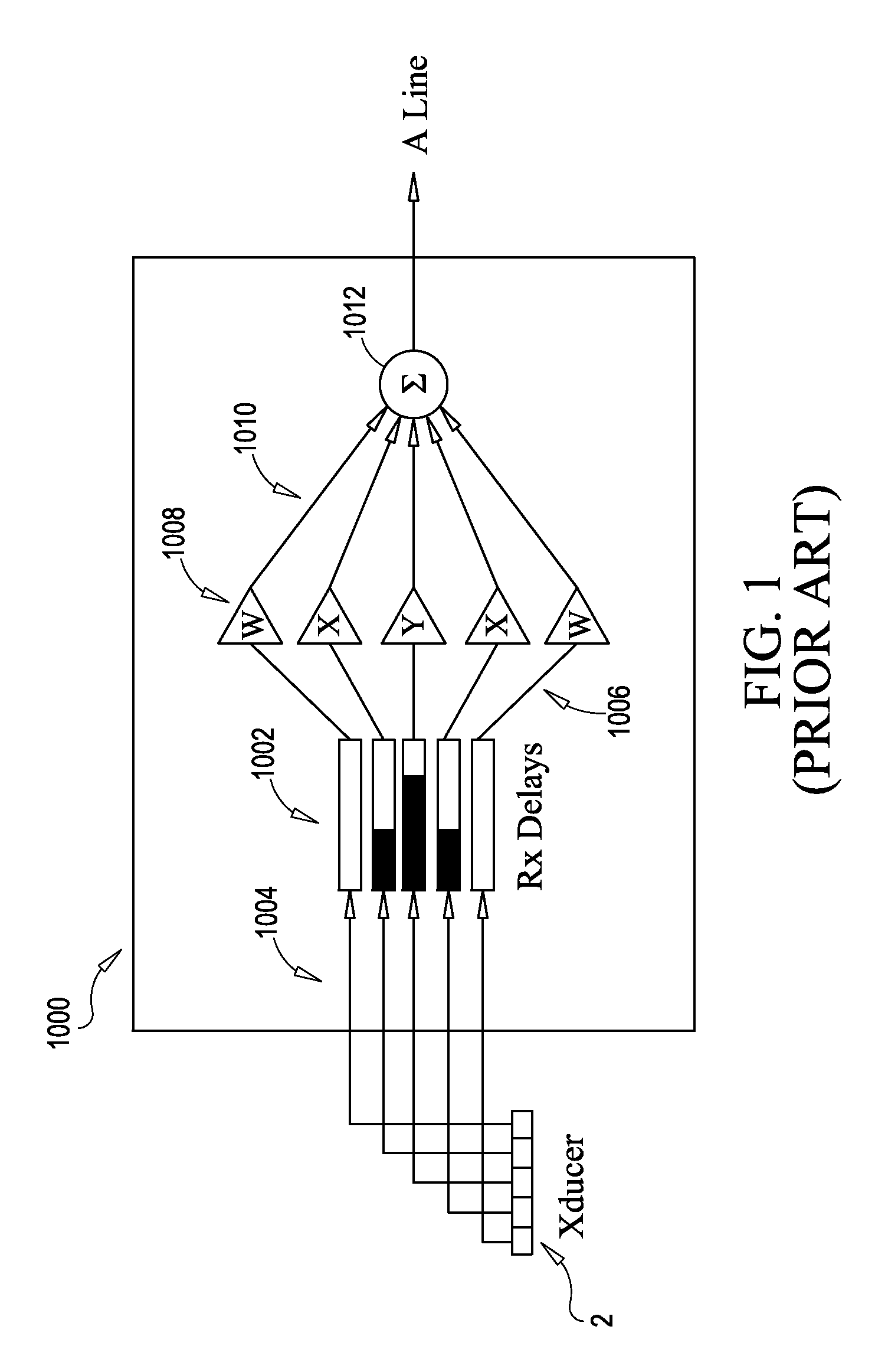Imaging or communications system utilizing multisample apodization and method
a multi-sample, imaging or communication system technology, applied in the field of array-based imaging and sensing, can solve the problems of imperfect solution, affecting the quality of imaging, and almost never true for medical ultrasound imaging, and achieve the effect of facilitating optimization of contrast resolution of a broadband signal
- Summary
- Abstract
- Description
- Claims
- Application Information
AI Technical Summary
Benefits of technology
Problems solved by technology
Method used
Image
Examples
example 1
Comparing the FIR (Non-Robust) and the DAS Beamformers
[0249]A 64 element 150 μm pitch 1D linear array operating at 6.5 MHz and 75% fractional bandwidth was simulated, using DELFI, a custom ultrasound simulation tool (e.g., see Ellis et al., “A Spline Based Approach for Computing Spatial Impulse Responses”, IEEE Trans. on Ultrason., Ferroelect., Freq. Contr., vol. 54, no. 5, pp. 1045-1054, 2007, which is hereby incorporated herein, in its entirety, by reference thereto) that can be downloaded from the Mathworks MATLAB (The Mathworks, Inc. Natick, Mass.) file exchange website (mathworks.com / matlabcentral). All calculations were performed on an IBM Intellistation Z Pro (Processor speed 2.80 GHz, 4.00 Gb RAM. IBM Corporation, Armonk, N.Y.).
[0250]Instantaneous spatial responses were calculated in a 2D plane, azimuth and range, with a particular receive focus. Testing was performed to show the ability of the tap weights (QCLS) algorithm to produce optimal responses when using different FI...
example 2
Performance of the Non-Robust FIR Beamformer in the Presence of Phase Aberration
[0263]Receive channel focal delays 1002 in the prior art DAS beamformer 1000 are calculated assuming a propagation speed of sound in tissue. Conventional systems assume a uniform sound velocity of 1540 m / s, however actual sound velocities in human tissue vary between human subject and tissue type. Spatial variations from the assumed sound speed cause wavefront distortion, amplitude variation, and phase variation of the ultrasound beam. These distortions or phase aberrations adversely affect the quality of in vivo images. Phase aberration will distort the DAS beamformer's 1000 ISR, reducing the contrast and resolution of the output image.
[0264]Recent literature indicates that phase aberrations in the human breast can be modeled as a nearfield thin phase screen characterized by a root mean square (RMS) amplitude strength of 28 ns and a full-width at half-maximum (FWHM) correlation length of 3.6 mm. A serie...
example 3
Application to an Ultrasonic Scanning System
[0271]An embodiment of the beamformer 10 according to the present invention was applied to an existing ultrasound scanner to improve the spatial response characteristics thereof. The ultrasonic scanner system used was the Ultrasonix Sonix RP ultrasound scanner (Ultrasonix Medical Corp., Richmond, BC, Canada). The Sonix RP system has a software development kit (SDK) named TEXO that enables low level scanner control with the ability to acquire single channel RF data sampled at 40 MHz with 12 bit precision. The present inventors created an interface to the TEXO SDK using PYTHON™ programming language that allowed creating of customized pulse sequences without the need to recompile the system C code. Utilizing the PYTHON™ interface with the TEXO SDK a full set of synthetic receive aperture data was acquired from a 64 element transmit aperture and 64 element receive aperture in fractions of a second. In order to measure the 2D ISR required for t...
PUM
 Login to View More
Login to View More Abstract
Description
Claims
Application Information
 Login to View More
Login to View More - R&D
- Intellectual Property
- Life Sciences
- Materials
- Tech Scout
- Unparalleled Data Quality
- Higher Quality Content
- 60% Fewer Hallucinations
Browse by: Latest US Patents, China's latest patents, Technical Efficacy Thesaurus, Application Domain, Technology Topic, Popular Technical Reports.
© 2025 PatSnap. All rights reserved.Legal|Privacy policy|Modern Slavery Act Transparency Statement|Sitemap|About US| Contact US: help@patsnap.com



